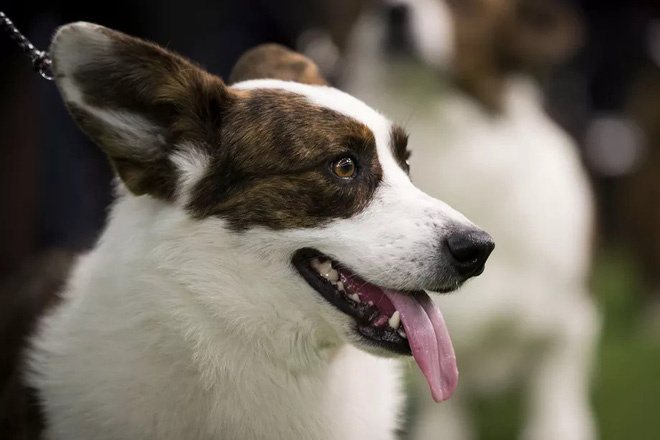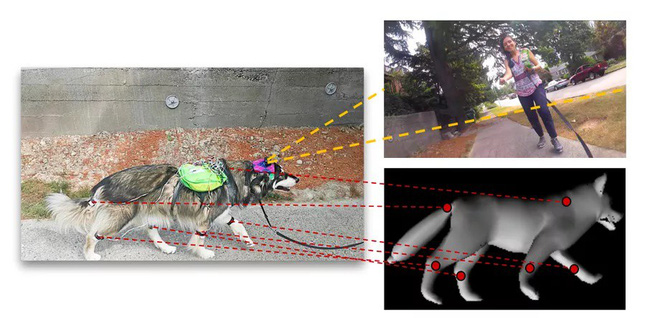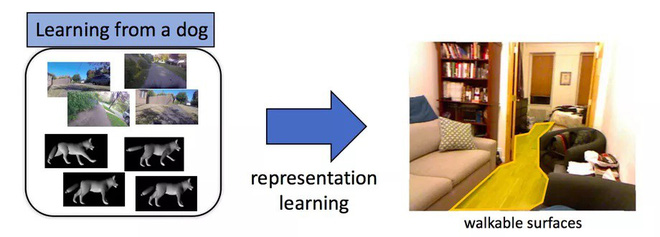Researchers teach AI how to think like a dog and learn about the world around it
What can artificial intelligence learn from a dog? Plenty - researchers from the University of Washington and the Allen Institute of AI say. Recently, they created and trained AI to explain and predict dog behavior. Scientists say animals can provide a new source of training data for AI systems - including those used to control robots.

To train AI to think like a dog, researchers first need to have data. They gathered this information in video form by shooting the action of a Malamute dog named Kelp. A total of 380 short videos were shot from a GoPro camera mounted on the dog's head along with motion data from sensors on the legs and torso. Basically, Kelp was recorded in motion the same way as Hollywood actors using CGI (Computer Imaging Technology).
With these data in hand, the researchers analyzed Kelp's behavior using deep learning technology. This is an AI technique used to filter samples from a database. In this case, that means the AI will combine Kelp's limb motion data and visual data from GoPro to find a common relationship with dog activities. This information will be used to train the AI to predict how the dog will react in certain situations.
Talking to The Verge, lead author of the article, Kiana Ehsani explained that the predictive power of this AI system is accurate, but only for a short time. In other words, if the video shows an image of a stairway, you can guess the dog will climb them. But it is only a possibility, situations in life are not always simple to be accurately predicted. Ehsani, a graduate student at the University of Washington, says whether a dog will climb sometimes depends on whether it sees an attractive object or toy upstairs.

In another aspect of the research, scientists know that dogs 'show intelligence in their ability to observe, perceive food, obstacles, humans and other animals'. So can we train AI systems to react smartly like a dog in such situations?
The sentence is the word 'yes' but the ability is still very limited. The researchers applied two tests to their AI systems, asking it to identify different contexts (e.g. indoors, outdoors, on stairs, on balconies) and 'corpses'. The surface can be walked '. In both cases, the AI completed these tasks with great precision using basic data on dog movements and shelter.
Ehsani said: 'A dog's intuition is really good at determining where to walk. This is quite a difficult job with previous computer systems because it needs a lot of data. This knowledge may be a too sloping surface for walking or gaps that make it difficult to walk on. It takes a lot of time to program a robot with all these rules, but a dog will always know all this. So by monitoring Kelp's behavior, the AI system learns these rules without having to be taught. In other words, it learned from a dog.
Everything must be considered to proceed carefully. The software created by Ehsani and colleagues is not a brain model or a dog's consciousness. All it's doing is learning some very basic rules from a limited data set, like where dogs like to go for a walk. Similar to every other AI system, it simply finds patterns in the data. This is nothing new because scientists always train similar AI systems from databases.

However, Ehsani points out that this is the first time an AI system can learn from a dog and that animal data is also useful in developing AI systems that serve children. people. A dog can learn many useful things with robots. For example, dogs can recognize what people look like, the differences between adults and children. Dogs know how to avoid cars and walk up the stairs safely, these are valuable lessons for any robot (controlled by AI) when it works in the human environment.
Of course, this article is just a very simple demonstration of how we can learn from animals but there is much more work to be done before this model works. But Ehsani is confident that it will bring more useful applications in the future. She said: 'This research made me immediately think of developing a robotic dog. It is a difficult job for a robot dog, it must know how to move and automatically decide where to go, what target to pursue.
The new research will certainly help us develop a better and more effective robot dog. '
Reference: Theverge
You should read it
- The world's most complicated maid robot dog will be released later this year
- Attack of security robots, a man is 'wanted'
- Robots are also 'fired' before the technology industry's cost-cutting efforts
- Listed 10 most beautiful dog breeds in the world
- Surprise with Guinness records in the cat and dog world
- Top 10 fastest running dogs in the world
- Startled with the future changing technologies will be popular in 2025
- When the dogs act their 'gods' in front of the camera
May be interested
- Activities to help children learn critical thinking
 as a parent, you can encourage your child to think critically with some activities at home. here are some activities to help you understand how to teach critical thinking to your child.
as a parent, you can encourage your child to think critically with some activities at home. here are some activities to help you understand how to teach critical thinking to your child. - China's largest quantum computing chip allows access to researchers around the world
 scientists from the chinese academy of sciences (cas) have developed xiaohong, the largest quantum computing chip built by the country to date with 504 qubits, expected to enable researchers around the world to access limit.
scientists from the chinese academy of sciences (cas) have developed xiaohong, the largest quantum computing chip built by the country to date with 504 qubits, expected to enable researchers around the world to access limit. - Old-fashioned manners that every parent should teach their children
 saying thank you or please is just the tip of the iceberg when it comes to teaching politeness to children. below are some basic or minimal politeness that every parent should teach their children from a young age.
saying thank you or please is just the tip of the iceberg when it comes to teaching politeness to children. below are some basic or minimal politeness that every parent should teach their children from a young age. - How to sign up Zoom.us learn online for free
 zoom.us is a web version of zoom software on computers, supports online learning via zoom and users who register an account on zoom.us.
zoom.us is a web version of zoom software on computers, supports online learning via zoom and users who register an account on zoom.us. - The three 'golden' philosophies of Jack Ma, every parent should read so they can be used to teach their children
 if your child's dream can become extremely successful in whatever you choose to do in the future, here are three views from jack ma that parents can apply to teach their children to become successful people like this talented billionaire.
if your child's dream can become extremely successful in whatever you choose to do in the future, here are three views from jack ma that parents can apply to teach their children to become successful people like this talented billionaire. - Learn JavaScript through puzzles with Grasshopper
 grasshopper uses small games or puzzles to teach users about javascript.
grasshopper uses small games or puzzles to teach users about javascript. - The most difficult language to learn in the world, 10 years of learning are basic communication
 pirarra uses both singing, whistling and other expressions to communicate.
pirarra uses both singing, whistling and other expressions to communicate. - Study and have fun with the game Toca Life World
 toca life world is not only considered a game, but also considered by many parents as an application for children to learn and play at the same time. below is the link to download toca life world apk from lmhmod and learn more about the characteristics, features as well as evaluate the health and safety level of the game.
toca life world is not only considered a game, but also considered by many parents as an application for children to learn and play at the same time. below is the link to download toca life world apk from lmhmod and learn more about the characteristics, features as well as evaluate the health and safety level of the game. - How to teach children how to use the mouse?
 being able to use a mouse proficiently is useful for many things, from playing games, navigating the internet to creating digital artwork and potentially a child's future career.
being able to use a mouse proficiently is useful for many things, from playing games, navigating the internet to creating digital artwork and potentially a child's future career. - The story is worth pondering about an American mother who teaches her child to be independent: 'Please don't help my child!'
 many parents maintain the idea that because their lives are lacking, they must work hard to cultivate their children. however, this is a completely wrong way to raise children.
many parents maintain the idea that because their lives are lacking, they must work hard to cultivate their children. however, this is a completely wrong way to raise children.










 Megaverse: A 'zero-gravity' case that allows smartphones to be mounted on any surface
Megaverse: A 'zero-gravity' case that allows smartphones to be mounted on any surface When Bitcoin went everywhere: using NES since 1985 dig Bitcoin
When Bitcoin went everywhere: using NES since 1985 dig Bitcoin Surely gamers will love this waterproof shoe, less than a week and earned more than 16 billion on Kickstarter
Surely gamers will love this waterproof shoe, less than a week and earned more than 16 billion on Kickstarter Xenxo S-Ring: The smartest ring in the world, expensive but capable of everything
Xenxo S-Ring: The smartest ring in the world, expensive but capable of everything This is a self-propelled boat capable of taking on the role of bridges
This is a self-propelled boat capable of taking on the role of bridges Masta Box: When a fidget cube is not just a toy to play with
Masta Box: When a fidget cube is not just a toy to play with